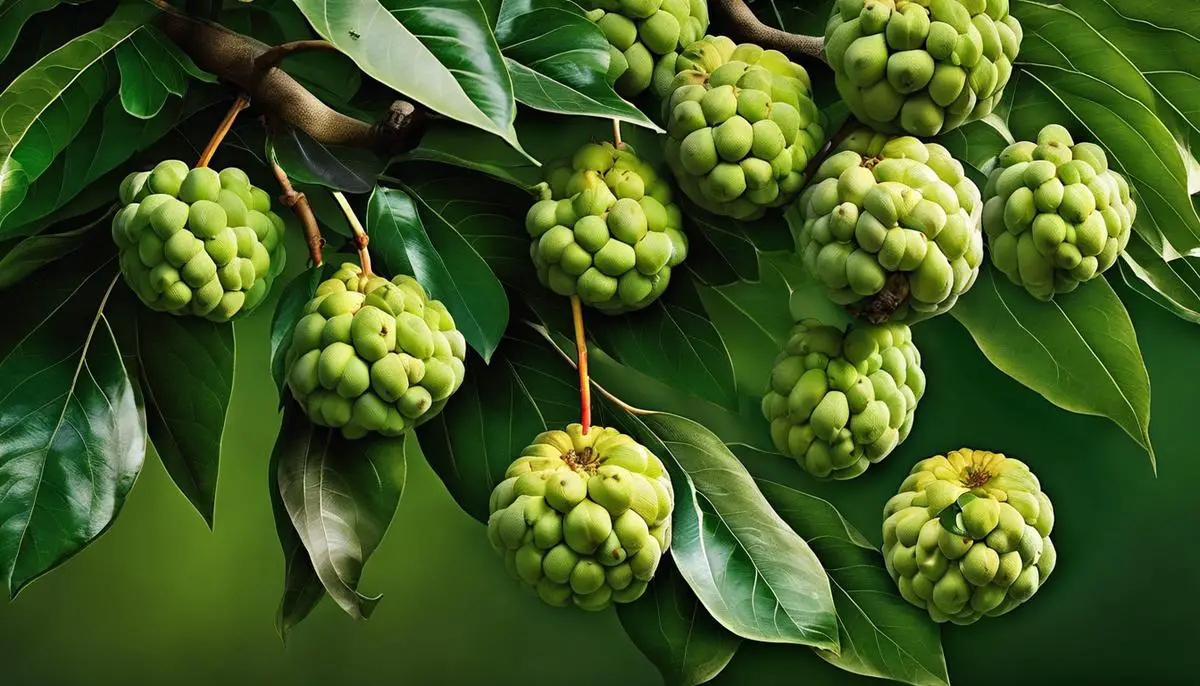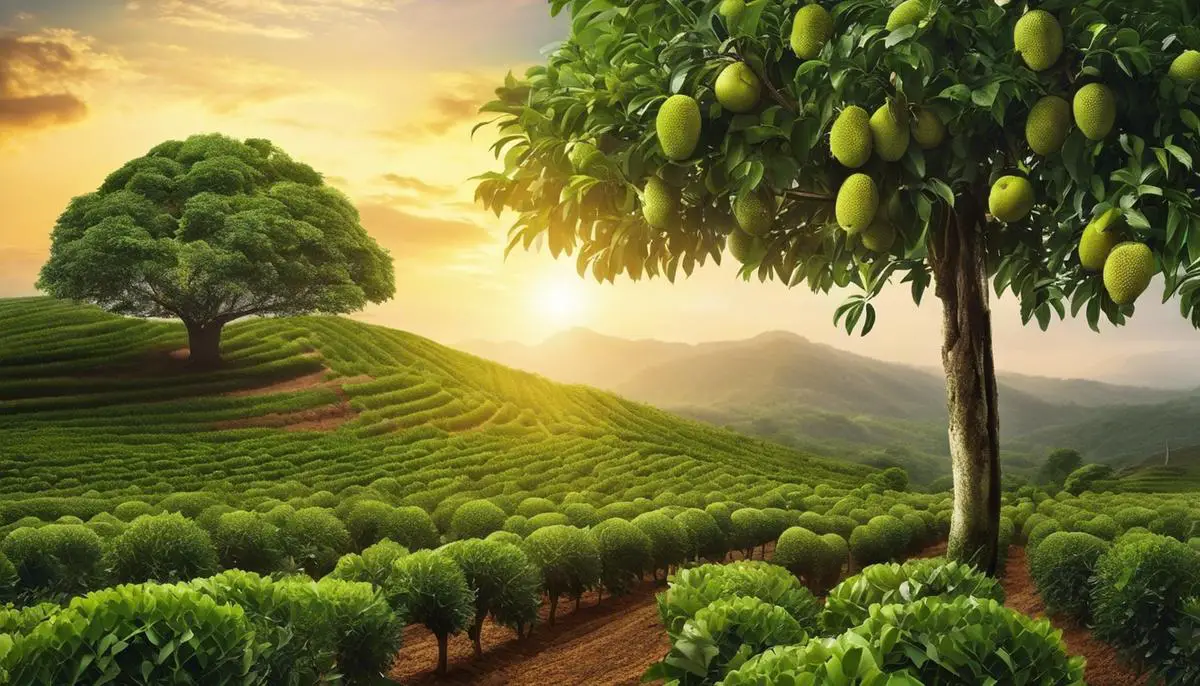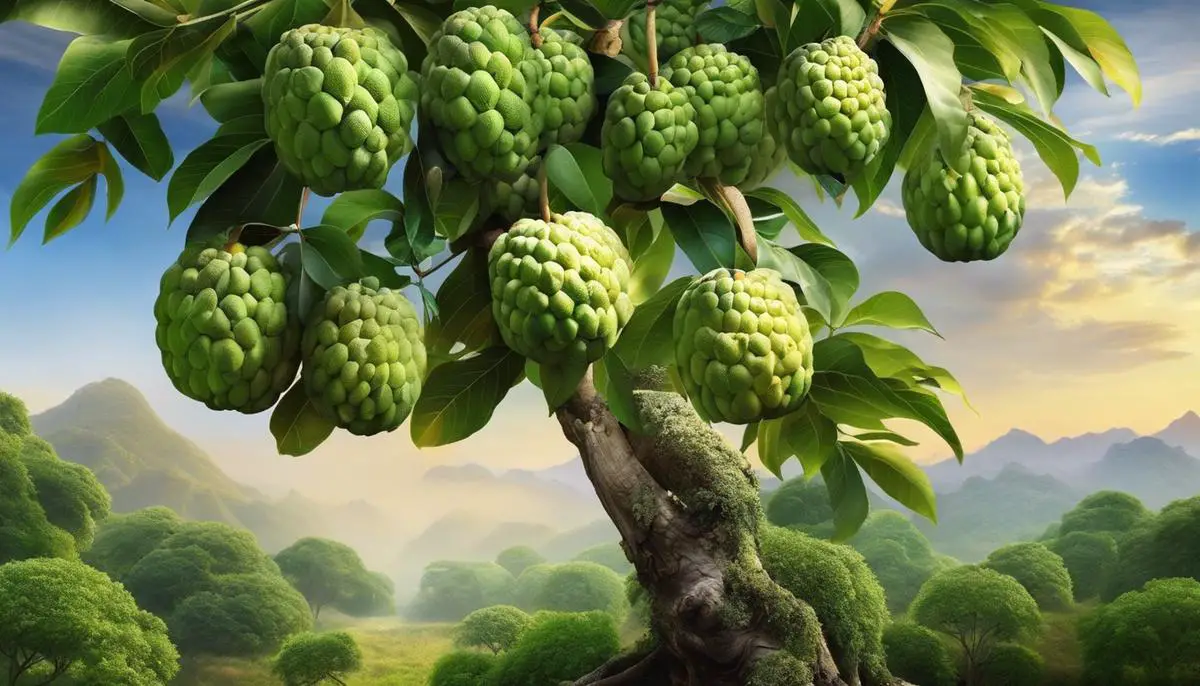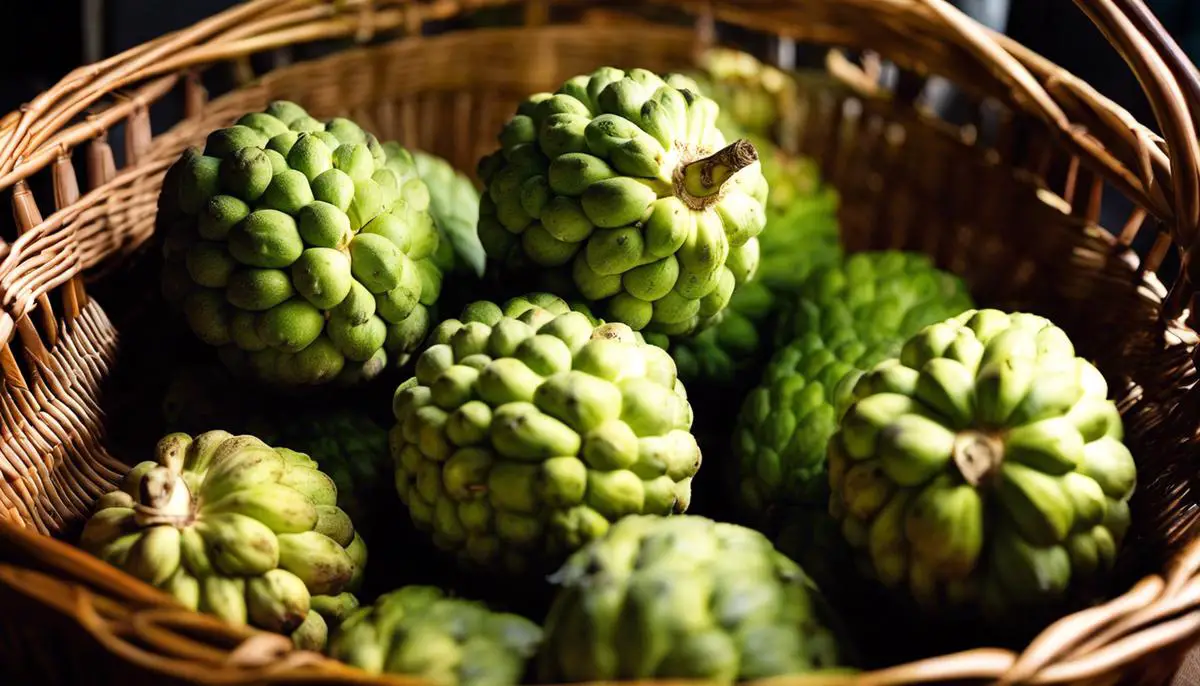The Custard Apple Tree, scientific name ‘Annona reticulata’, is an exquisite species abundantly bestowed with qualities that set it apart from other members of the plant kingdom. This essay enlightens not only with its enthralling physical features but also takes a deep dive into the dynamic lifecycle, comprehensive growth process, and meticulous care required for this unique and splendid tree. We journey through the tree’s humble inception as a delicate seed, maturity into a magnificent tree, down to its feather in the cap – the nourishing Custard Apples. Loaded with value-added topics like the nurturing and harvest of these fruits along with their usage in culinary arts and medicine, a whole new world of knowledge awaits those who seek to understand the magnificence of the Full Custard Apple Tree.
Understanding the Anatomy of a Full Custard Apple Tree
Discovering the Unique World of Custard Apple Trees
Set amid the verdant backdrop of nature, the Custard Apple Tree stands as a reflection of the bountiful and enchanting symbiosis between mankind and the plant world. Known by the botanical name Annona reticulata, this lovely perennial plant carves its niche with awe-inspiring features, asserting its distinct personality and holding its ground amidst a forest of botanical variety. One can’t help but marvel at its unique anatomy and how it diverges from those of conventional trees.
The Custard Apple Tree, in its full grandeur, doesn’t quite mimic the towering and majestic stature of oaks or pines. In fact, the tree typically sprouts to a modest height of 15 to 35 feet. It’s not overly sprawling canvas-like branches, but rather a cluster of compact, spread-out limbs, which gives the tree a bushy look.
The real fascination lies in the trifoliate arrangement of its leaves. They grow in groups of three, presenting an interesting geometric pattern unlike the singular sprouting leaves of other trees. Each leaf is large, shiny, and oblong and measures about 4 to 8 inches long and 1 to 2 inches wide. They stand evergreen through the year, contributing to the overall aesthetic appeal of the tree.
The bark of a Custard Apple Tree is another distinctive feature. It’s not the typical brown, textured bark that one gets used to seeing on most trees. This tree adorns a grayish-black, almost smooth, even bark. Its appearance assumes significance since it is believed to possess several medicinal properties.
The fascinating fruit that the tree bears is its unique selling point. The fruits aren’t just insignificant pods that follow the flowers; they are special. They give the Custard Apple Tree not just its name, but also its charm and utility. The fruit, which is typically round or heart-shaped and measures about 4 inches, has a sweet creamy texture akin to custard – hence the name, Custard Apple.
The Custard Apple Tree further fascinates with its blooming cycle, which can happen anytime throughout the year. It not just blooms, but blooms in style, flaunting gorgeous umbellate flowers. The pistils and stamens peek from the flower base, making it an exquisite sight to behold. This blooming feature sets it apart from other trees, whose flowering often follows a seasonal calendar.
Like all good things in life, growing a Custard Apple Tree isn’t a mere cakewalk. It demands patience, dedication, and to a certain extent, expertise. But the distinctive features of the Custard Apple Tree – the unique leaf arrangement, the intriguing bark, the all-year-round blooming, and the luscious custard apples – make all the efforts worthwhile. The appreciation of this tree is not just about understanding its anatomy, it’s about embracing the tree’s multiplicity, its production, and most importantly, its impact on our biosphere. It embodies the beauty and marvel of simple things that stand out in their diversity. Let’s admit it, we all could use a little of that custard apple charm in our lives!

The growth process of the Full Custard Apple Tree
Finding Ground for your Custard Apple Tree
Selecting the right spot for planting a Custard Apple is quintessential for its optimum growth. A location with six to eight hours of sunlight is indispensable to encourage photosynthesis and subsequently fruit development. A northerly exposure helps the tree avoid the intensity of summer midday sun which could pose a risk for the young plant.
Regulating Moisture Levels: Going Beyond the Basics
Custard Apple Trees are moisture-loving plants that require regular watering, especially in warmer regions. Cover the soil with organic mulches like leaf litter or wood chips to slow down water evaporation. But avoid water-logging the soil; it poses a serious threat of root rot disease that can weaken, and even kill the tree. Remember, maintaining a balance is the key.
Soil: Housing the Roots
Custard Apple Trees thrive in rich, well-draining soils with a pH range of 6.5 to 8.0. The soil should be loamy and light to support root growth. The roots need to breathe, and compact soil can hinder the passage of nutrients, stunting the tree’s development.
Growth Pattern: A Little Patience Goes a Long Way
Custard Apple Trees are relatively slow-growing. They can reach up to 15-35 feet in height at maturity, but getting there will require some patience. During its initial growing phase, the tree focuses mainly on establishing its root system and maintaining its leafy canopy. But with a little patience, time will eventually come when the tree bursts into a profusion of green leaves and tempting fruits.
Schedule for Pruning: Creating Space for Growth
Pruning is an essential part of CSCustard Apple Tree care. Branches that are low growing, crossing each other or look diseased and damaged should be pruned off in late winter when the tree is still dormant. This not only helps maintain the shape and size of the tree, but also promotes better air circulation, preventing the spread of plant diseases.
Pests and Diseases: A Watchful Eye
It is useful to know about common pests and diseases that can harm a Custard Apple Tree. Watch out for pests like the annona seed borer, mealy bugs and scale insects. Fungal diseases are also a concern. Use organic pesticides and fungicides to keep your tree both healthy and safe.
Pollination: Nature’s Magic
While many fruiting trees are self-pollinating, Custard Apple Trees require cross-pollination for fruiting. Apart from bees, Custard Apple Trees also get pollinated by beetles or other insects. If you wish to ensure fruiting, you can manually pollinate the flowers as well.
Among the many joys of nurturing a Custard Apple Tree, perhaps the greatest is watching it bear fruit. But it’s not just about the final result; it’s about the journey. Nurturing a Custard Apple Tree is a hobby that rewards patience and fosters an intimate connection with nature. Enjoy the efforts you put in and the tree will surely reward you with its delectable fruits!

Caring for a Full Custard Apple Tree
Integrated Care and Maintenance of a Full Custard Apple Tree
Commencing an ardent journey of growing a full custard apple tree requires careful attention to several considerations—the foremost being the tree’s location. Much akin to us humans choosing our homes, custard apple trees value their surroundings. These trees relish well-drained, frost-free spaces with ample exposure to sunlight. A north-facing spot in your backyard, supplied with at least five hours of sunlight, could make for an idyllic growing spot.
Watering forms the life source for these tropical wonders. It is highly essential to sustain a delicate balance; while they treasure deep watering throughout the hot summer months, it’s important to avoid water-logging which might lead to the tree’s roots rotting. In general, a deep watering once a week suffices, yet remember, moderation is key.
Sounds like a fuss? Yet, the pleasure of watching the tree flourish under your care is downright fulfilling. But the absolute ecstasy is coupled with ensuring the custard apple tree’s soil requirements. They cherish rich loam or sandy soil, with a slightly acidic pH level – between 6.5 to 7.5. A good mix of organic compost, perhaps some well-rotted cow manure, along with the topsoil can prove to be a nutritious blend for your tree’s root system.
Now that our tree has made itself at home, it’s time to talk about its pace. “Slow and steady” could be the motto of these plants indeed. Patience then, must be your gardening virtue. Custard apple trees are slow growers, taking about three to four years to bear fruit. Set aside any haste, instead revel in the serene journey of nurturing the tree to fruition.
As the tree matures, pruning becomes mandatory for maintaining its shape and size. Late winter or early spring makes the optimal pruning season as the tree is yet to enter its growth phase. Pruning not only helps in maintaining aesthetics but also assists in fruit production and overall tree health.
Much like any other fruit-bearing trees, custard apple trees also endure their share of pests and diseases. Mealybugs, fruit flies, and bark caterpillars pose frequent threats, while fungal infections like leaf spot and root rot are common diseases. Integrated pest management and regular tree inspection is a godsend for these trees, ensuring a healthy and pest-free life.
To reap the harvest of custard apples, cross-pollination is crucial. Unsurprisingly, nature has its own way when it comes to custard apple trees, with female and male flowers opening at different times to prevent self-pollination. Hand-pollination could be employed as a supplemental aid, indulging in the marvels of natural processes.
And there you have it—the scrupulous yet delectably satisfying form of caring for a full custard apple tree. With these best practices, you’re well on your way to become a proud caretaker of your very own custard apple tree. The joy and spirit of nurturing, coupled with the divine taste of the fruit itself make this fruit tree a real horticultural pleasure. Remember, trees, just like us, respond to love and care. Embrace the joy of growing!

Harvesting and Uses of the Full Custard Apple
After giving so much love and care to your custard apple tree, isn’t it exciting to think about the final reward – plucking fresh, ripe custard apples! But the question is – when is the right time to harvest? Like all good things, it requires some knowledge and patience.
Custard apples are ready to harvest when their skins take on a lighter shade, and tiny artificial “scales” start to lift. A soft yet firm pressure applied to the fruit, which should give slightly, is another sign of readiness. As opposed to some other fruits, custard apples will continue to ripen once picked. When you spot these signs, it’s time to pull out your harvesting basket and get to picking!
Timing the harvest right is crucial for the taste and texture of the fruit. Too early, and the fruit will be too hard and lacking in taste. Too late, and it could be overripe and start to ferment. Generally, custard apples are in peak season from early fall through winter, but regional climates can affect this timing.
So, we know when to pluck the fruits. But that’s only half of the story. What about the multitude of ways to enjoy this delicious, nutrient-dense fruit? That’s an exciting topic in itself!
When ripe, custard apples offer a sweet, slightly tangy flavor that is nothing short of delightful. They can be enjoyed right off the tree, their soft, creamy pulp eaten straight from the skin. They make for a great addition to fruit salads, offering a unique flavor that complements other fruits well.
Custard apples also star in many dessert recipes throughout the world. They make delicious ice creams and sorbets, giving them a natural sweetness that’s hard to beat. Custard apple smoothies are gaining popularity, with their creamy texture and health benefits making way for a guilt-free indulgence.
But don’t discard those seeds! Despite not being edible, they have insecticidal properties and can be ground and used as a natural solution for managing pests in your garden. Even the leaves, when dried, are made into tea and used in traditional remedies.
Having a custard apple tree is genuinely rewarding. From planting the first seed to tending to the tree, mapping its growth, and eventually enjoying the fruits of your labor, every step offers a sense of accomplishment. Getting to harvest and use the fruit is merely the icing on the cake!
Remember, each tree is unique, and experiences may differ. But with a little knowledge, a sprinkle of patience, and lots of love, anyone can enjoy the wonders of nurturing a custard apple tree. Here’s to your green thumbs, may they bring forth many lush, bountiful custard apple seasons to come!

The Full Custard Apple Tree is a living testament to the magical variety of nature. Harnessing the necessary wisdom to explore its sublime anatomy, comprehend its growth process, provide the appropriate care and acknowledge its wide range of practical uses, not only encapsulates the beauty of the tree, but also the remarkable potential of its delicious, health invigorating fruit. As we journey through the lifecycle of the Full Custard Apple tree and its fruit, nurturing and learning from it, we gain a profound appreciation for the diversity and richness of the world around us. Here’s to celebrating the marvel and blessing that is the Full Custard Apple Tree, and the innumerable ways it enhances our lives with its taste and vital abundance.
